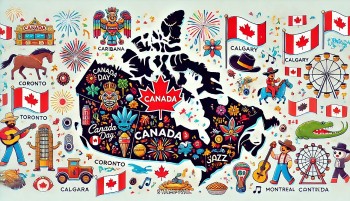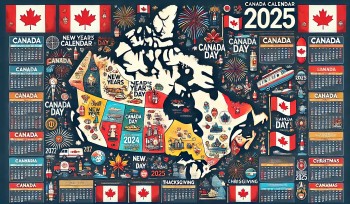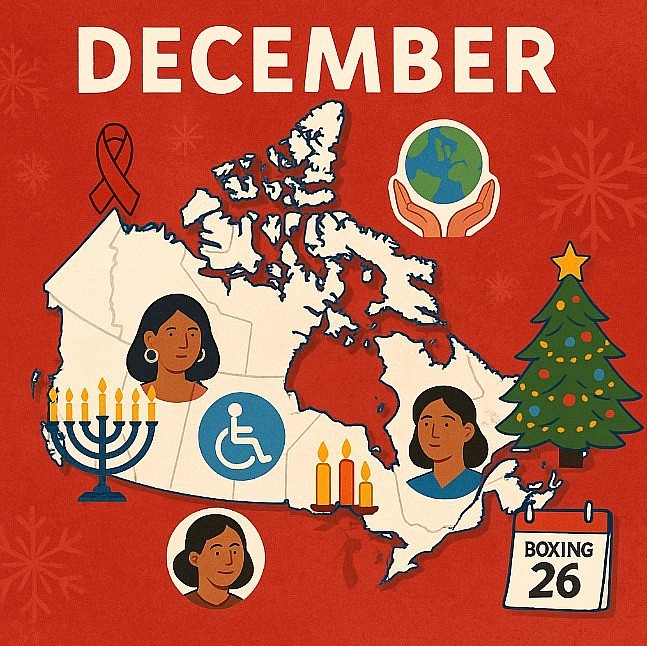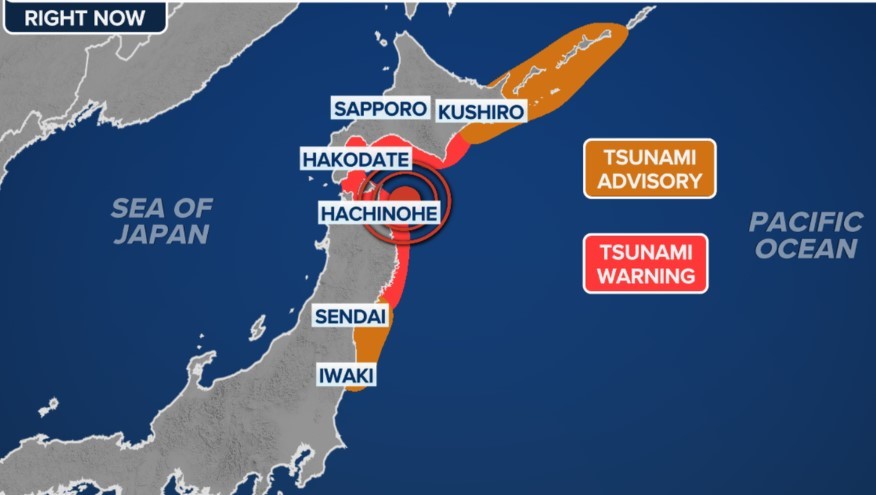Canada Calendar in December: National Holidays, Special Days and International Events
 10 Biggest Holidays and Festivals in Canada 2025 10 Biggest Holidays and Festivals in Canada 2025 |
 2025 Canada Calendar - Full List of Public Holidays And Observances: Dates, Activities 2025 Canada Calendar - Full List of Public Holidays And Observances: Dates, Activities |
 |
| Canada Calendar December |
December is a rich month for many countries — and in Canada it offers more than winter scenery and festive cheer. From national statutory holidays through to internationally recognised awareness days, December in Canada blends public rest days with reflection, culture, and global connectivity. In this article we’ll map out the key dates in Canada’s December calendar: which days are legally mandated holidays, which are significant commemorative observances, what international days are noted in Canada, and how Canadians typically mark them.
We’ll also explore regional nuances (provinces and territories sometimes differ), cultural backgrounds, tips for businesses and travellers, and what to keep in mind if you’re planning events around these dates. By the end you’ll have a full-spectrum view of December’s calendar in Canada, optimised for SEO with keywords such as Canada December holidays, Canada December calendar, special days Canada December, and Canada international events December.
1. Statutory and Public Holidays in Canada in December
1.1. National statutory holidays
In Canada, public holidays can be federal (applicable to federal employees and federally regulated workplaces) and provincial/territorial (applicable within a province or territory). According to the federal regulator, the Canada Revenue Agency (CRA), the following apply for December:
-
Christmas Day (December 25): A national public holiday in Canada.
-
Boxing Day (December 26): Recognised in many jurisdictions as a statutory holiday.
These days are typically days off for many workplaces and schools, but coverage can vary by province and industry.
1.2. Provincial/territorial differences & optional holidays
While Christmas Day is broadly covered, Boxing Day’s status can vary. For example:
-
In Ontario and many provinces, Boxing Day is a statutory holiday.
-
In some jurisdictions, it may be listed as an “optional holiday” rather than a full paid statutory holiday.
For travellers or event organisers, it’s worth checking local labour/holiday legislation for the specific province or territory (e.g., Quebec, Alberta, British Columbia) if you’re expecting staffing or access issues.
1.3. Practical implications for December
-
Many businesses, schools and public services will close or operate reduced hours on December 25 and December 26.
-
Travel, tourism, and retail sectors will be particularly busy (and sometimes interrupted) around these dates.
-
For anyone doing business internationally or remotely with Canadian partners, knowing that December 25 (and often December 26) are non-working days is crucial for scheduling.
-
For event planning, December is already a busy season (holiday events, end-of-year wrap-ups) and the public holidays affect timing, staffing, and logistics.
2. Important Commemorative & Special Days in December in Canada
Beyond the major holiday closures, December in Canada features several important commemorative days: days of reflection, activism, heritage, and awareness. These may not always mean a day off for everyone, but they are significant in social/cultural context.
2.1 Key Canadian commemorative days
-
December 3 – International Day of Persons with Disabilities
Designated in Canada as a day to raise awareness of accessibility, inclusion, and the rights of persons with disabilities. -
December 6 – National Day of Remembrance and Action on Violence Against Women
A day of national significance in Canada marking the anniversary of the 1989 tragedy at the École Polytechnique de Montréal. Flags at federal buildings fly at half-mast and a minute of silence is encouraged. -
December 10 – Human Rights Day
Recognised in Canada among other nations, marking the adoption of the Universal Declaration of Human Rights. -
December 11 – Anniversary of the Statute of Westminster
Though less widely observed, this marks the act (1931) that gave Canada legislative independence from the British Parliament.
2.2 Why these days matter
-
Social awareness and policy relevance: For example, December 6’s day is a way for Canadian society to focus on gender-based violence and reflect on progress and challenges.
-
Educational opportunities: Schools and universities often schedule programming (lectures, discussions, campaigns) around these dates.
-
Organisational and corporate engagement: Many businesses incorporate awareness campaigns or allyship initiatives tied to these commemorative days.
-
Cultural and civic identity: Celebrating or recognising Canadian-specific days deepens civic consciousness and national identity.
2.3 How Canadians observe them
-
On December 6, many Canadians wear a white or purple ribbon in solidarity.
-
On December 3 and December 10, organisations may hold seminars, publish reports, or run social-media campaigns for accessibility/human rights.
-
Government buildings will flag accordingly; educational institutions may adjust schedules or set aside time for remembrance.
-
While these days are not typically full holidays (day off work) across the board, they are included in national commemorative calendars.
3. International and Global Awareness Days in December Seen in Canada
Canada participates in many internationally recognised days and global observances in December. These capture broader themes — from environmental issues to health to global social justice. For anyone planning communications, marketing or programming in December, knowing these days helps in content planning and alignment.
3.1 Selected highlight days
According to a calendar of international days applicable in Canada:
-
December 1 – World AIDS Day
-
December 2 – International Day for the Abolition of Slavery; also Giving Tuesday (although that shifts year to year)
-
December 4 – International Day of Banks
-
December 5 – International Volunteer Day; also World Soil Day
-
December 6 – (as above) plus other global recognitions
-
December 10 – Human Rights Day (see above)
-
December 11 – International Mountain Day
-
December 14 – 21 – Observances like Hanukkah (dates vary), plus many cultural and religious calendars
-
December 21 – Winter Solstice (Northern Hemisphere)
-
December 22 – 28 – Various days depending on year: e.g., Kwanzaa often begins December 26 or 27. In Canada, Kwanzaa is observed by some communities.
3.2 Why they’re relevant in Canada
-
Canada is a multicultural, globally connected country. Recognising international days underscores its role in global conversations.
-
Businesses, NGOs and educational institutions often tie campaigns or programming to these days (e.g., awareness of HIV/AIDS, soil health, mountains and environment).
-
Media and social-media calendars often reference these days—helpful for content planning, marketing, CSR.
-
For travel-industry and event-industry professionals, these days may coincide with specific programming or peak times.
3.3 Planning Tips
-
If you’re producing digital content in December (blogs, newsletters, social posts) use these international days as anchor points.
-
For organisations with global connections, align your staffing, communication or operations with major days (for example volunteer programmes around December 5).
-
For educational institutions, incorporate sessions or modules addressing these topics.
-
For travellers or service providers, note that while these days are “marked”, they may not be official holidays—so normal business may still apply, but thematic programming or events may be more frequent.
4. Cultural and Seasonal Notes for December in Canada
Beyond official holidays and awareness days, December in Canada is shaped by culture, weather, seasonality and tradition. Understanding the broader context adds depth to any calendar-based planning.
4.1 Seasonal context
-
December in Canada means winter (in many regions) — shorter daylight hours, snow in many provinces, cold weather. Businesses, events and travel operate in that context.
-
The festive season runs through late December (Christmas, New Year). While New Year’s Day is in January, many Canadians begin celebrating or winding down in late December.
-
Retail, tourism, hospitality are high-demand sectors; likewise transportation may be more stressed due to holiday travel.
-
Some regions slow down—schools may break, many companies may reduce operations in the last week of December.
4.2 Cultural traditions
-
Christmas is widely celebrated (for many Canadians) though Canada’s diversity means there are also many non-Christian traditions.
-
The day after Christmas, Boxing Day, has shopping and retail significance (sales, promotions) in many parts of Canada.
-
Some specific regional traditions: for example, in Newfoundland & Labrador there is a folk observance called Tibb’s Eve on December 23 (though not a statutory holiday).
-
Among Canada’s multicultural communities, December may include observances such as Hanukkah, Kwanzaa, and other cultural or religious celebrations. For example, Kwanzaa has growing recognition in Canada.
4.3 Business and event-planning implications
-
For businesses: year-end operations often wind down in December; closing times, staffing, and logistics may shift.
-
For events: many holiday events (corporate parties, community festivals) are concentrated in early to mid-December; scheduling should avoid clashes with statutory holidays and busy travel dates.
-
For travel: flights, hotels may be busier and more expensive; winter weather may cause disruption; transportation services may have altered schedules around holidays.
-
For charity and social work: the holiday season sees increased giving and volunteering (ties in with December 5’s International Volunteer Day). Many NGOs or community groups ramp up campaigns.
5. Month-by-Month Breakdown: December Calendar Snapshot for Canada
Here’s a practical breakdown of December in Canada, highlighting the major days to watch. Note: some days shift depending on year, province, or weekends.
| Date | Day | What’s Happening |
|---|---|---|
| December 1 | e.g., Monday (depending year) | World AIDS Day – awareness of HIV/AIDS. |
| December 2 | – | International Day for the Abolition of Slavery / Giving Tuesday / other observances. |
| December 3 | – | International Day of Persons with Disabilities (Canada). |
| December 5 | – | International Volunteer Day / World Soil Day. |
| December 6 | – | National Day of Remembrance and Action on Violence Against Women (Canada). |
| December 10 | – | Human Rights Day. |
| December 11 | – | International Mountain Day / Anniversary of Statute of Westminster. |
| December 21 | – | Winter Solstice in Northern Hemisphere. |
| December 23 | – | In some regions: Tibb’s Eve (NL) & other cultural observances. |
| December 25 | – | Christmas Day (statutory holiday). |
| December 26 | – | Boxing Day (often statutory). |
| December 26 onwards | – | Some multicultural observances begin (e.g., Kwanzaa begins December 26 in many places). |
Because December is also the tail end of the year, many organisations treat the last week (e.g., December 27-31) as a wind-down period, even if not officially designated as holidays.
6. Tips and Best Practices for Using the December Calendar in Canada
Whether you’re planning business operations, content marketing, travel, events, or community programming, here are some concrete tips for leveraging Canada’s December calendar:
6.1 For business and staffing
-
Confirm if December 25 and December 26 are paid holidays in your province/territory for your workforce.
-
Plan for lower staff availability or closed periods; set customer expectations accordingly.
-
When working with international partners, avoid scheduling key deadlines or major launches on or immediately after December 25/26.
-
Allow for winter-weather delays in logistics, shipping, and staffing.
6.2 For content, marketing and communications
-
Map content themes around international days: e.g., December 3 (Disabilities Day), December 6 (Violence Against Women), December 10 (Human Rights) for campaigns.
-
Use holiday-themed content (Christmas, Boxing Day sales) while respecting cultural sensitivity and diversity.
-
Highlight CSR initiatives around giving, volunteering, accessibility, inclusion.
-
Schedule posts and communications early (e.g., before the holiday break) because activity may drop during the last week of December.
6.3 For event and travel-planning
-
Travel and accommodation may be in higher demand; book early if planning December activities.
-
For events, avoid scheduling on public holidays unless the event is holiday-themed (people may prefer rest).
-
Consider weather logistics: snowy conditions, shorter daylight hours, winter driving conditions.
-
Leverage cultural and community dates (e.g., December 6) for targeting audiences with meaningful programming.
6.4 For personal planning and cultural sensitivity
-
Be aware that not every Canadian observes Christmas; embrace inclusive language and programming for diverse audiences.
-
If travelling across provinces, note that holiday observance and business closures may vary regionally.
-
Recognise local traditions: e.g., Tibb’s Eve in Newfoundland & Labrador, Kwanzaa in some communities.
-
For service providers, consider customer expectations: big retail sales often land on Boxing Day.
7. Looking Ahead: Why December Matters & What to Watch
7.1 Year-end significance
December is more than just “holiday month”: it’s a crux point in the year for business closure, annual reporting, reflection and planning for the next year. The statutory holidays combined with awareness days amplify this.
7.2 Engagement opportunities
-
Organisations can tie their year-end branding or social responsibility efforts to December’s theme days (volunteerism, human rights, inclusion).
-
Retail and e-commerce players can capitalise on the holiday consumer behaviour (especially Boxing Day).
-
Travel and tourism can leverage winter-specific experiences (ski resorts, winter festivals) while mindful of holiday breaks.
7.3 Emerging patterns and trends
-
In recent years, increasing recognition of multicultural observances (such as Kwanzaa) in Canada signals broader inclusive trends.
-
Content marketers and social campaigns are aligning more tightly with the international days in December (e.g., social justice, disability rights).
-
Winter weather and climate change may influence how December events and operations are planned (logistics disruptions, weather-adapted planning).
Conclusion
December in Canada is layered: it includes statutory holidays (notably Christmas Day and often Boxing Day), commemorative national days (like December 6’s National Day of Remembrance and Action on Violence Against Women), and numerous international awareness days (such as World AIDS Day and Human Rights Day) that are observed and leveraged in Canadian contexts.
For anyone interacting with the Canadian calendar — whether running a business, planning content, organising events, or simply scheduling travel — being attuned to these dates is critical. Understanding the blend of legal closures, cultural observances and global-themed days allows for smoother planning, better engagement, and inclusive outreach.
As you prepare for December, remember: the major public holidays may be obvious, but the “special days” offer deeper opportunities to connect meaningfully with communities, audiences and stakeholders across Canada.
FAQs
Q1: Is Boxing Day (December 26) a statutory holiday everywhere in Canada?
A: Not uniformly. Boxing Day is recognised in many jurisdictions as a statutory holiday (e.g., Ontario) but other provinces/territories may treat it as an optional holiday or have different rules. It is prudent to check local legislation.
Q2: Are December 3, 6 and 10 days off in Canada?
A: Generally, no. These days (International Day of Persons with Disabilities, National Day of Remembrance and Action on Violence Against Women, Human Rights Day) are commemorative days rather than full statutory holidays across the board. They tend to be observed through events, campaigns or remembrance rather than business closures.
Q3: How can organisations use the December calendar for marketing or CSR?
A: Organisations can align campaigns with awareness days (e.g., accessibility or human rights days), plan holiday-themed promotions (e.g., around Christmas or Boxing Day sales), and ensure inclusive messaging that recognises diverse cultural observances. Scheduling content ahead of holiday-week closures is also advisable.
Q4: Does the December calendar change depending on province/territory?
A: Yes. While federal holidays provide a baseline (like Christmas Day), provincial/territorial rules may alter whether a day is paid, optional or closed. Additionally, cultural observances may vary regionally. Always check the local context.
Q5: What’s the best way to plan travel or events around December in Canada?
A: • Book early due to high demand in travel and hospitality.
• Avoid major launches or deadlines on or just after December 25/26 — many people and businesses are off.
• Consider winter weather logistics and daylight factors.
• Take into account extra planning for community/cultural observances tied to awareness days.























